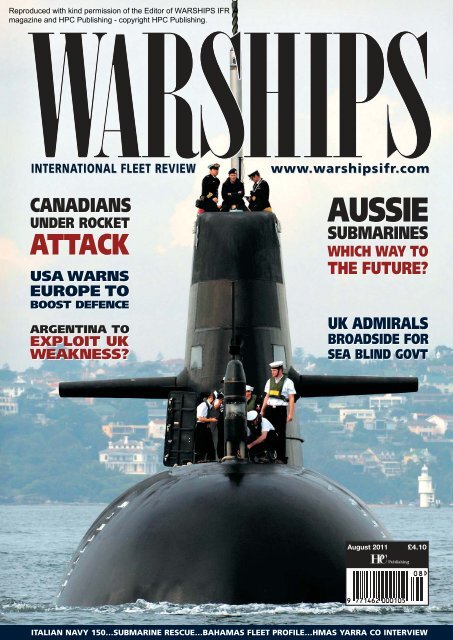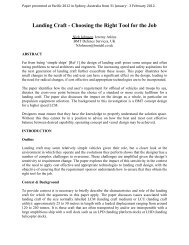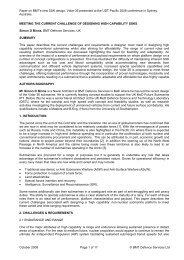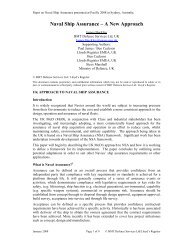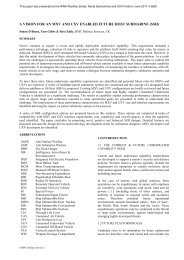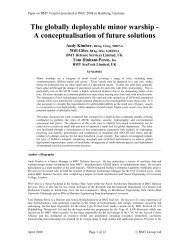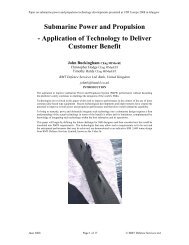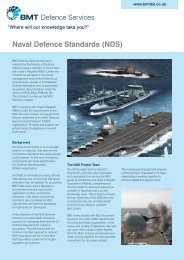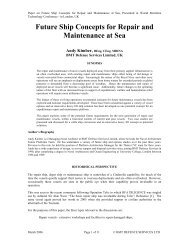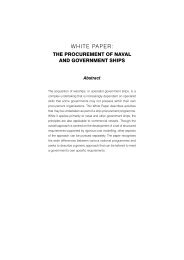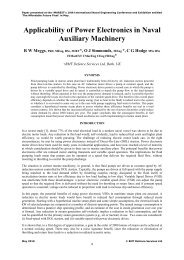Which Way to the Future?
Which Way to the Future?
Which Way to the Future?
You also want an ePaper? Increase the reach of your titles
YUMPU automatically turns print PDFs into web optimized ePapers that Google loves.
INTERNATIONAL FLEET REVIEW<br />
CANADIANS<br />
UNDER ROCKET<br />
ATTACK<br />
USA WARNS<br />
EUROPE TO<br />
BOOST DEFENCE<br />
ARGENTINA TO<br />
EXPLOIT UK<br />
WEAKNESS<br />
www.warshipsifr.com<br />
AUSSIE<br />
SUBMARINES<br />
WHICH WAY TO<br />
THE FUTURE<br />
UK ADMIRALS<br />
BROADSIDE FOR<br />
SEA BLIND GOVT<br />
August 2011 £4.10<br />
ITALIAN NAVY 150…SUBMARINE RESCUE…BAHAMAS FLEET PROFILE…HMAS YARRA CO INTERVIEW
AUSTRALIAN FUTURE SUBMARINES<br />
WHICH WAY TO<br />
The <strong>Future</strong><br />
USMAN ANSARI REPORTS ON HOW DELAYS IN<br />
BEGINNING CONSTRUCTION OF AUSTRALIA’S NEXT<br />
GENERATION SUBMARINES PROBABLY RESULT FROM<br />
THE ALMOST UNIQUE OPERATIONAL REQUIREMENTS<br />
FACED BY THE RAN’S SUBMARINE FORCE. HE ALSO<br />
LOOKS AT SOME SURPRISING SOLUTIONS ON OFFER.<br />
Fears Australia’s technological<br />
edge is being eroded by <strong>the</strong><br />
proliferation of advanced<br />
submarines in Asia-Pacific<br />
continue <strong>to</strong> drive calls for<br />
construction <strong>to</strong> commence on<br />
Australia’s next generation boat.<br />
Improving airborne Anti-<br />
Submarine Warfare (ASW)<br />
capability and upgrading <strong>the</strong><br />
Collins Class submarines may<br />
help, but fears of a capability gap<br />
are hard <strong>to</strong> ignore. Considering<br />
Australia’s somewhat unique<br />
operational circumstances, <strong>the</strong><br />
delays while a variety of<br />
requirements undergo scrutiny<br />
are understandable. Endurance<br />
and range sufficient for<br />
operations across <strong>the</strong> region<br />
imposes <strong>the</strong> so-called ‘tyranny of<br />
distance’, which necessitates<br />
Australia acquiring a vessel quite<br />
unlike European built or designed<br />
submarines, which operate<br />
relatively close <strong>to</strong> <strong>the</strong>ir own home<br />
bases. As suggested in articles<br />
published in preceding editions of<br />
this magazine, a nuclear-powered<br />
attack boat (SSN) would seem a<br />
sensible solution, providing range<br />
and speed. However, political<br />
opposition <strong>to</strong> nuclear power<br />
currently rules out nonconventional<br />
submarines - <strong>the</strong><br />
idea of having nuclear refuelling<br />
facilities on Australian soil is a<br />
non-starter - but a lack of such<br />
supporting civilian nuclear<br />
infrastructure need not in itself<br />
hinder acquisition of SSNs. The<br />
UK-origin Astute’s Rolls Royce<br />
PWR-2 and <strong>the</strong> Virginia’s S9G<br />
reac<strong>to</strong>rs will not require refuelling<br />
during <strong>the</strong>ir operational lifetimes,<br />
<strong>the</strong>refore <strong>the</strong>y could <strong>the</strong>oretically<br />
be operated without <strong>the</strong> nuclear<br />
support infrastructure. The<br />
Kokoda Foundation has<br />
recommended purchase of<br />
Virginia Class submarines due <strong>to</strong><br />
<strong>the</strong> benefits of joint support<br />
inherent with working closely<br />
alongside <strong>the</strong> US Navy. However,<br />
<strong>the</strong> Astute should perhaps not be<br />
overlooked. With its economy in<br />
dire straits <strong>the</strong> British government<br />
may well look favourably on an<br />
Australian request if only <strong>to</strong><br />
reduce <strong>the</strong> unit cost of providing<br />
<strong>the</strong> Royal Navy with is seven<br />
examples of <strong>the</strong> SSN type.<br />
Compared <strong>to</strong> <strong>the</strong> Virginia Class,<br />
available figures show <strong>the</strong> Astute<br />
<strong>to</strong> be smaller, faster, and having<br />
a slightly smaller complement.<br />
The possibility of carrying out<br />
some of <strong>the</strong> build in Australia is<br />
quite feasible, due <strong>to</strong> <strong>the</strong> modern<br />
modular construction methods. It<br />
would safeguard <strong>the</strong> skills and<br />
submarine construction<br />
infrastructure, ensuring <strong>the</strong><br />
capability of being able <strong>to</strong> carry<br />
out indigenous refits and of<br />
course refuelling would not pose<br />
an obstacle. Politically and<br />
economically industrial offsets are<br />
also fac<strong>to</strong>rs, and <strong>the</strong>re are wider<br />
benefits <strong>to</strong> be had for Australian<br />
industry that could, for example,<br />
come from acquiring advanced<br />
steel fabrication and welding<br />
techniques.<br />
Industrial and operational<br />
benefits aside however, nuclear<br />
submarines are still expensive <strong>to</strong><br />
acquire, need larger crews than<br />
conventional boats (raising longterm<br />
running costs), and could<br />
perhaps lead <strong>to</strong> a smaller number<br />
procured due <strong>to</strong> costs. Therefore<br />
if <strong>the</strong> aim is <strong>to</strong> keep force levels<br />
up, crew sizes down but still<br />
maintain endurance, range and<br />
speed, is it possible after all that<br />
<strong>the</strong>re could be a conventional<br />
solution Continuing<br />
improvements in battery<br />
technology and Air Independent<br />
Propulsion (AIP) systems may<br />
deliver a reasonable capability in<br />
a conventional submarine<br />
(especially one of 4,000 <strong>to</strong>ns). Or<br />
perhaps radical new technologies<br />
will provide a performance<br />
comparable <strong>to</strong> non-conventional<br />
submarines BMT Defence<br />
Services Ltd has explored<br />
concepts that could provide <strong>the</strong><br />
answers, resulting in <strong>the</strong> Vidar-36<br />
and Ship Submersible Gas<br />
Turbine (SSGT) designs.<br />
Developed in conjunction with<br />
Rolls-Royce, <strong>the</strong> SSGT mounts a<br />
pair of twin independent gas<br />
turbines in a fin-<strong>to</strong>p ‘bulb’.<br />
Burning a mixture of<br />
kerosene/paraffin and air drawn<br />
in from an extendable mast, <strong>the</strong><br />
submarine acts as a semisubmersible<br />
and can make<br />
extended high-speed transits of<br />
6,000 nautical miles at 20 knots.<br />
Contrastingly, <strong>the</strong> given range for<br />
a submerged Collins Class<br />
submarine at 21 knots is 32.6<br />
nautical miles. Additional stealth<br />
in transit is provided by reformed<br />
kerosene in <strong>the</strong> fuel stacks being<br />
used <strong>to</strong> produce hydrogen that is<br />
combusted during ‘snorting’,<br />
resulting in a range of 13,000<br />
nautical miles at ten knots.<br />
S<strong>to</strong>red liquid oxygen can also be<br />
used in conjunction with <strong>the</strong> AIP<br />
system <strong>to</strong> propel <strong>the</strong> submarine<br />
at ten knots. Equally remarkable<br />
is <strong>the</strong> SSGT’s submerged ‘sprint’<br />
speed of 30 knots when powered<br />
by its ZEBRA batteries. Coupled<br />
with advanced electronics and<br />
sensors, six 21-inch <strong>to</strong>rpedo<br />
tubes, eight external Vertical<br />
Launch System (VLS) tubes for<br />
heavier ordnance like cruise<br />
missiles, 12-man Special Forces<br />
support capability (with<br />
equipment s<strong>to</strong>red under casing<br />
and ability <strong>to</strong> carry Swimmer<br />
Delivery Vehicles), plus a small<br />
complement of 25, <strong>the</strong> SSGT<br />
seems worth considering. Like all<br />
radical new technologies,<br />
however, <strong>the</strong> SSGT, (or variant<br />
<strong>the</strong>reof) if chosen could take<br />
some time <strong>to</strong> come <strong>to</strong> maturity in<br />
technological terms, so could<br />
push back filling of <strong>the</strong> Australian<br />
submarine gap even fur<strong>the</strong>r. Also,<br />
being only semi-submerged for a<br />
long distance transit, regardless<br />
of <strong>the</strong> speed, is perhaps a notion<br />
submariners are uncomfortable<br />
with. With advanced battery and<br />
AIP technologies <strong>the</strong> Vidar-36<br />
may perhaps be regarded as a<br />
‘safer’ alternative. The<br />
conventional modular design<br />
seems <strong>to</strong> offer an affordable<br />
ocean-going submarine that<br />
takes <strong>the</strong> latest commercial off<strong>the</strong>-shelf<br />
technology (COTS) <strong>to</strong><br />
produce a 3,600 <strong>to</strong>ns submarine<br />
with a range of 9,000nm<br />
(snorting). Options are available<br />
<strong>to</strong> fur<strong>the</strong>r increase range and <strong>the</strong><br />
design is capable of being<br />
tailored <strong>to</strong> meet specific cus<strong>to</strong>mer<br />
requirements. It also allegedly has<br />
highly-capable land attack and<br />
ASW/Anti-Surface Warfare<br />
(ASuW) capabilities, enhanced<br />
communications and network<br />
centric capabilities. There are also<br />
facilities <strong>to</strong> support special<br />
operations by embarking a tenman<br />
special forces team with<br />
<strong>the</strong>ir equipment and <strong>the</strong> ability <strong>to</strong><br />
launch and recover te<strong>the</strong>red and<br />
au<strong>to</strong>nomous Unmanned<br />
Underwater Vehicles (UUVs).<br />
Just what form Australia’s new<br />
submarines will take <strong>the</strong>refore<br />
remains <strong>to</strong> be seen, but if<br />
meeting <strong>the</strong> operational<br />
requirements means pushing <strong>the</strong><br />
boundaries of technology,<br />
construction is likely <strong>to</strong> be<br />
delayed for some time yet,<br />
meaning that <strong>the</strong> Collins Class<br />
will have <strong>to</strong> soldier on.<br />
PUTTING RADICAL MOVES INTO THE MIX<br />
TIM HARDY, SENIOR NAVAL ENGINEER OF BMT DEFENCE SERVICES<br />
WRITES ABOUT HIS COMPANY’S INNOVATIVE DESIGN PROPOSALS,<br />
WHICH COULD ATTRACT THE RAN.<br />
The Vidar-36 and SSGT were developed with an eye on such markets<br />
as Australia and both designs continue <strong>to</strong> attract interest. The SSGT<br />
was developed as a mechanism for us <strong>to</strong> understand and investigate<br />
how more novel technologies could be combined in<strong>to</strong> a submarine<br />
platform <strong>to</strong> deliver effect comparable <strong>to</strong> a SSN. We also wished <strong>to</strong><br />
challenge traditional thinking on diesel-electric attack submarine (SSK)<br />
propulsion by introducing a number of innovations which, while<br />
unproven <strong>to</strong>ge<strong>the</strong>r, were based on known technology programmes.<br />
We used <strong>the</strong> exercise <strong>to</strong> help us expose various design constraints and<br />
by easing some of <strong>the</strong>m a little could determine what effect such an<br />
approach would have on <strong>the</strong> overall submarine design. One outcome<br />
of such an approach was our acceptance that we would never meet<br />
<strong>the</strong> Indiscretion Ratios (IR) - <strong>the</strong> ratio of time spent at periscope depth<br />
snorting <strong>to</strong> time completely submerged - that an SSN achieves. By<br />
introducing a more integrated propulsion system matched <strong>to</strong> an<br />
appropriate hull form that maximised <strong>the</strong> submarine’s near-surface<br />
mobility characteristics we began <strong>to</strong> counter <strong>the</strong> obvious SSK versus<br />
SSN (IR) shortfalls during transit <strong>to</strong> and from an area of operations. The<br />
Ship Submersible Gas Turbine (SSGT) remains an interesting concept for<br />
conventional submarines requiring <strong>the</strong> capability <strong>to</strong> transit vast<br />
stretches of ocean and high performance capability. It should, however,<br />
be recognised that a number of <strong>the</strong> underpinning technologies we<br />
have proposed are still at low maturity levels and would need<br />
significant technology development programmes <strong>to</strong> bring <strong>the</strong>m <strong>to</strong> a<br />
level where confidence in <strong>the</strong> feasibility of <strong>the</strong> concept could be gained.<br />
Clearly, many navies are developing very stretching requirements that<br />
current off-<strong>the</strong>-shelf SSK designs may struggle <strong>to</strong> meet. We use designs<br />
such as Vidar-36 <strong>to</strong> emphasise that we understand such needs and also<br />
turn people’s attention <strong>to</strong> our core submarine market offering, namely<br />
whole submarine design and our ability <strong>to</strong> advise cus<strong>to</strong>mers on <strong>the</strong> art<br />
of <strong>the</strong> possible with novel requirements. The Vidar-36 should be viewed<br />
as a design point ra<strong>the</strong>r than a design solution; we recognise that client<br />
nation needs vary and a single solution is unlikely <strong>to</strong> meet a specific<br />
requirement. Therefore we use concept designs such as Vidar-36 as a<br />
starting point <strong>to</strong> investigate design trade-offs <strong>to</strong> meet more specific<br />
capability requirements.<br />
SUBMARINE<br />
SOLUTIONS<br />
HMS Astute, first of a new breed of<br />
British SSN, could also be <strong>the</strong> answer<br />
for <strong>the</strong> RAN<br />
Pho<strong>to</strong>: LA(Phot) A.J. Macleod/RN.<br />
Left, inset: USS Virginia, a potential<br />
alternative solution for Australia.<br />
Pho<strong>to</strong>: William Pittman/US Navy.<br />
Left: An artist impression of <strong>the</strong><br />
revolutionary SSGT concept offered.<br />
Image: BMT Defence Services.<br />
38 39


